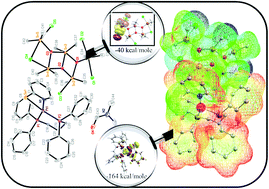A serendipitous isolation of cocrystallized platinum–tin complexes: synthesis, structure and theoretical exploration†
Abstract
The reaction of [PtCl2(P–P)] (P–P = PPh3, dppp) with [R2Sn(SeC5H4N)2] (R = Me, Et) afforded an orange co-crystallized product [{Pt(κ2-SeC5H4N)(P–P)}{R10Sn5(μ-O)3Cl5}] (P–P = PPh3, dppp; R = Me, Et). The latter complexes can also be obtained by the treatment of [Pt(SeC5H4N)2(dppp)] with R2SnCl2 (R = Me, Et). These co-crystallized complexes displayed a completely separated core of the platinum selenolate complex along with an organo-oxotin cage compound in the same lattice. These complexes were characterized by elemental analyses, NMR (1H, 31P, 77Se, 119Sn) spectroscopy and scalar relativistic density functional theory (DFT) calculations. The crystal structures of compounds [{Pt(κ2-SeC5H4N)(dppp)}{Me10Sn5(μ-O)3(μ-Cl)Cl4}]HCONMe2 (2a) and [{Pt(Cl)(SeC5H4N)(P–P)}{Et10Sn5(μ-O)3Cl5}] (2b) were established by single crystal X-ray diffraction analyses. Natural bond orbital (NBO) and energy decomposition analysis (EDA) were carried out in detail to establish the nature of bonding in both cocrystals. Their molecular structure contains nearly the same platinum fragment; however, the only variation that can be observed with the organo-oxotin cage fragment is that the methyl-substituted oxotin compound 2a is Cl-capped and the ethyl substituted one 2b is an O-capped type cluster.



 Please wait while we load your content...
Please wait while we load your content...